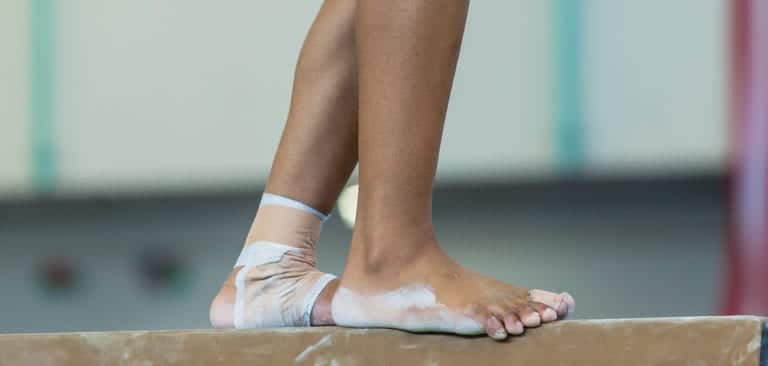
As a university athletic training student, the first thing we learned in class was how to tape an ankle. Taping the ankle was something athletic trainers would take pride in and it was always a competition as to who could tape the ankle the best and the quickest. But looking back now, after over 30 years of being an ATC, is ankle taping always appropriate for the ankle?
WHEN NOT TO TAPE YOUR ANKLE
As a university athletic training student working with the football program we taped the ankles of every player on the team at great expense and time. We taped perfectly healthy ankles with no previous injury history with the goal of helping to prevent the ankle injury during practice and games. Looking back at that experience, I don’t think that was a wise decision.
When you tape the ankle you are locking that ankle joint in a fixed position which would restrict normal up and down ankle range of motion necessary to run and jump at a high level. Why would you want to restrict normal, non-injury range of motion? The answer is you wouldn’t, and therefore I would advise against taping a perfectly healthy ankle to help prevent the ankle injury.
If you did play a sport with a high incidence of ankle injuries and wanted to protect your ankle I would suggest wearing an ankle brace with a hinge that would allow full up and down ankle range of motion. This way you get the performance of being able to move your ankle freely with the protection the ankle brace provides for excessive turning and twisting. Not to mention, studies have found “that ankle taping would be 3.05 times as expensive as ankle bracing over the course of a competitive season” so this method isn’t as cost effective in the long run.
WHEN TO TAPE YOUR ANKLE
Now, let’s say you do have a few previous ankle injuries and you want to tape your ankle to provide additional stability to help prevent future ankle injuries. Taping the ankle is perfectly fine in this situation as many collegiate and professional athletes routinely have the athletic trainer tape their ankles before every practice and game. In some circumstances, like gymnasts who don’t wear shoes in competition, ankle taping can be the only option for ankle injury prevention and in that case is better than no support at all.
Limitations of Ankle Taping
When taping your ankle, it’s important to keep in mind the limitations that taping can provide so that you choose the best way to protect yourself. One of the biggest limitations of tape is that like cheap, outdated lace-up ankle braces, tape that is used to wrap ankles is typically made of fabric. As you continue rigorous activity, the tape (like fabric) will become loose and unstable in a short amount of time reducing the amount of support it can ultimately give you.
When your ankle is taped in the commonly fixed 90º position, the tape will be forced to stretch, migrate, and shift during activity. When you’re playing your sport or moving around your ankle is moving up and down and constantly working against the tape. This will not only cause the tape to lose its structural integrity, but may also fatigue your ankle joint due to the extra effort it is putting forth to move in it’s natural range of motion.
SHARE WITH FRIENDS
RECENT POSTS
POST BY TOPIC
- Acute Ankle Injuries (7)
- Ankle Bracing (34)
- Ankle Injuries (16)
- Ankle Injury Prevention (20)
- Ankle Instability (6)
- Athletic Trainers (2)
- Athletic Training (3)
- Basketball (7)
- Football (9)
- High Ankle Sprain (4)
- Hiking (2)
- injury (1)
- Mild/Moderate Ankle Injury (2)
- News (2)
- Osteoarthritis (5)
- Pickleball (4)
- Soccer (5)
- Sports (16)
- Tennis (4)
- Ultra 360 Lace-Up (1)
- Ultra CTS (7)
- Ultra High-5 (1)
- Ultra Zoom (11)
- Volleyball (8)